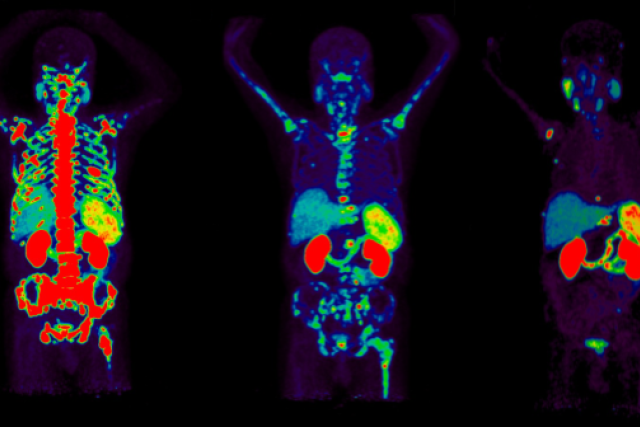Theranostics
Theranostics is a breakthrough precision medicine approach. By combining targeted imaging (PET scan) with targeted therapy (radionuclide therapy) using the same molecular target, it treats certain types of advanced cancer.
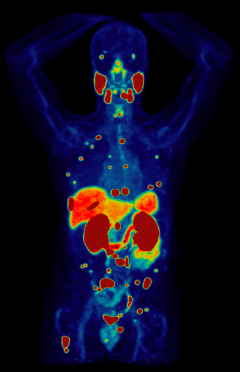
What is Theranostics?
Theranostics is a form of precision medicine that combines radioactive materials (radioisotopes) with molecules designed to target cancer cells. By attaching the radioisotope to the cancer-targeting molecule, UCLA Health physicians are able to see where the cancer is and then deliver therapeutic radiation directly to it.
By combining small amounts of radioactive material with cancer-targeting molecules, nuclear medicine physicians are able to diagnose, stage, and treat certain types of cancer. This combination of therapeutics and diagnostics is called theranostics.
Clinicians and scientists at the UCLA Health Theranostics Center leverage state-of-the-art technology and cutting-edge research to bring innovative and effective theranostic cancer treatments to our patients.
How does Theranostics work?
Certain radioisotopes emit radiation which is not harmful to cells and can be imaged using positron emission tomography (PET). This is the diagnostic part of theranostics. Others emit radiation which can damage and even kill cells. This is the therapeutic part.
Imaging
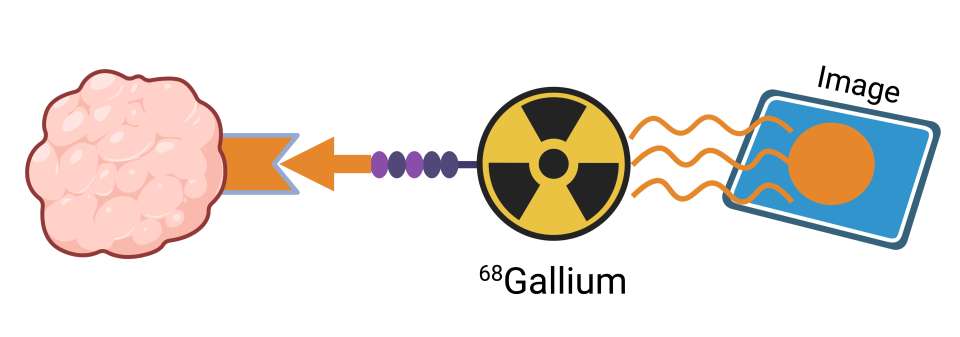
Therapy
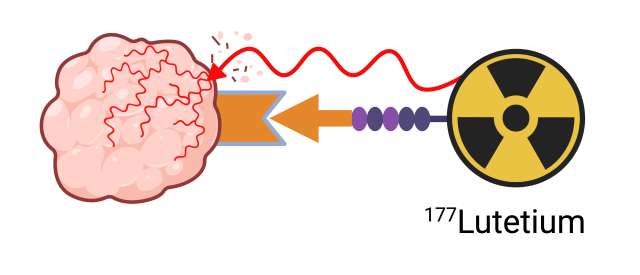
In theranostics, doctors administer a specialized molecule called a radiotracer that can hold a radioisotope and target cancer cells. The radiotracer then binds to the cancer, allowing doctors to see exactly where it is and deliver cell-damaging radiation directly to it. This “see what you treat” approach helps doctors diagnose, stage, and treat cancer while minimizing damage to healthy tissues.
What can you expect before, during & after theranostics imaging and therapy?
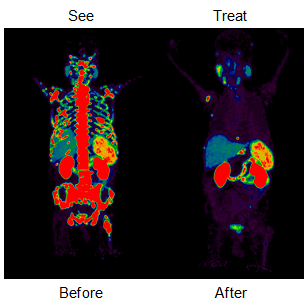
Before theranostics imaging and therapy:
Before beginning theranostics imaging and therapy, you will have a consultation with a UCLA Health Nuclear Medicine physician who will define treatment eligibility and explain side effects and effects of treatment. In addition to your consultation, you should:
- Activate your myUCLAhealth (MyChart) account
- Download the MyChart app to your smartphone
- Read education materials supplied by your health care team
- Contact your UCLA Theranostics care team with any questions
- Attend all appointments and screening tests to prepare for theranostics imaging and therapy
- Identify a contact person and one backup contact
- Review consent forms with your health care provider
- Identify transportation for your commute from the Outpatient Theranostics Center as you may receive anti-nausea medication that can make you drowsy
During theranostics imaging and therapy:
Theranostics is performed in an outpatient setting and consists of imaging (diagnostic) and therapy phases separated by several weeks. Two types of radiotracers are used: an imaging radiotracer which contains a radioisotope that can be imaged with PET, and a therapeutic radiotracer which contains a radioisotope that emits cell-damaging radiation. Throughout the entire process, your safety will be our top concern.
- Diagnostic Phase: To see where the cancer is, an imaging radiotracer will be administered by your health care team in our outpatient clinic. You will then undergo a full-body PET scan which will create pictures showing where the radiotracer goes. The whole process typically takes less than 3 hours, after which you can leave the clinic.
- Therapy Phase: To treat the cancer identified in the Diagnostic Phase, your health care team will administer a therapeutic radiotracer in our outpatient clinic. Following administration, you will be closely monitored by your care team for two to three hours, after which you will be able to leave the clinic. The number of therapy cycles you undergo will depend on the disease being treated, but can range from one to six.
After theranostics imaging and therapy:
Once the radiotracer has been administered, the cancer-targeting molecule will bind to the cancer before being naturally cleared from your body over the course of several days. While undergoing theranostics therapy, the therapeutic radiotracer will deliver cell-damaging radiation directly to the cancer cells until it is naturally cleared.
After completing all treatment cycles, your health care team may perform another PET scan to monitor how the cancer has responded to the treatment.
What theranostics therapies does UCLA Health offer?
At the UCLA Health Outpatient Theranostics Center, we offer state-of-the-art theranostics therapies for a number of indications.
- Prostate cancer: PLUVICTO and XOFIGO
- Neuroendocrine tumors (NETs): Lutathera
- Thyroid cancer and Graves’ Disease: RAI (radioactive 131Iodine)
Patient resources
Contact Us
For more information about theranostics imaging and therapy at UCLA Health, please call 310-794-1005.
Featured article links
Side effects of theranostics imaging and therapy
The most common side effect of theranostics imaging is claustrophobia during the full-body PET scan, while theranostics therapy can be accompanied by fatigue, constipation or diarrhea, dry mouth, nausea, anemia (below-normal red blood cell count), and bone pain. Less common side effects of theranostics therapy include decreases in cells that help fight infection.
Because side effects can vary depending on the disease being treated, it is important to consult with your theranostics care team prior to receiving treatment.
Who is a candidate for theranostics?
Theranostics treatments are available for certain patients with prostate cancer, neuroendocrine tumors (NETs), thyroid cancer, or Graves’ disease. Following diagnosis, your oncologist may refer you to the UCLA Health Theranostics care team for a consultation to determine whether you are a candidate for theranostics therapy.
Why choose UCLA Health for theranostics therapy?
You are in good hands when you choose UCLA Health for your theranostics therapy. Whether at our state-of-the-art Outpatient Theranostics Center or through our field-leading research in the laboratory and clinic, our team of physicians, researchers, and staff are focused on bringing the best care to our patients,
- Pioneering clinical trials: UCLA Health Theranostics physicians help bring innovative and effective treatments to UCLA Health patients by leading and participating in pioneering theranostics-based clinical trials such as NCT02940262. These studies led to FDA approval, Medicare reimbursement status, and inclusion in the prostate cancer management guidelines by the National Comprehensive Cancer Network (NCCN). The team led the Phase II RESIST-PC clinical trial to establish the safety and efficacy of Pluvicto (177Lu-PSMA-617) in treating metastatic castration-resistant prostate cancer, and participated in the pivotal Phase III VISION clinical trial which further demonstrated the efficacy of Pluvicto against metastatic castration-resistant prostate cancer. Based on the positive results of this study, the FDA approved Pluvicto for use in the United States.
- Experience and expertise: Since 2022, our team has administered over 430 cycles of theranostics therapy to patients with metastatic castration-resistant prostate cancer, NETs, thyroid cancer, and Graves’ disease.
- Theranostics research: UCLA is home to one of the premier theranostics research programs in the United States. Our researchers and clinicians collaborate closely to ensure that novel discoveries in the laboratory can be translated into meaningful clinical outcomes for patients at UCLA Health and beyond.
Click here to learn more about our cutting-edge research.
UCLA Health Outpatient Theranostics Center
Address: 100 UCLA Medical Plaza
Suite 700
Los Angeles, California 90095
Hours of Operation: Monday - Friday: 8 am- 5 pm
Phone: 310-794-1005
Meet our team
Technologists

Nursing

Administration

Contact us
For more information about theranostics imaging and therapy at UCLA Health, please call 310-794-1005.
